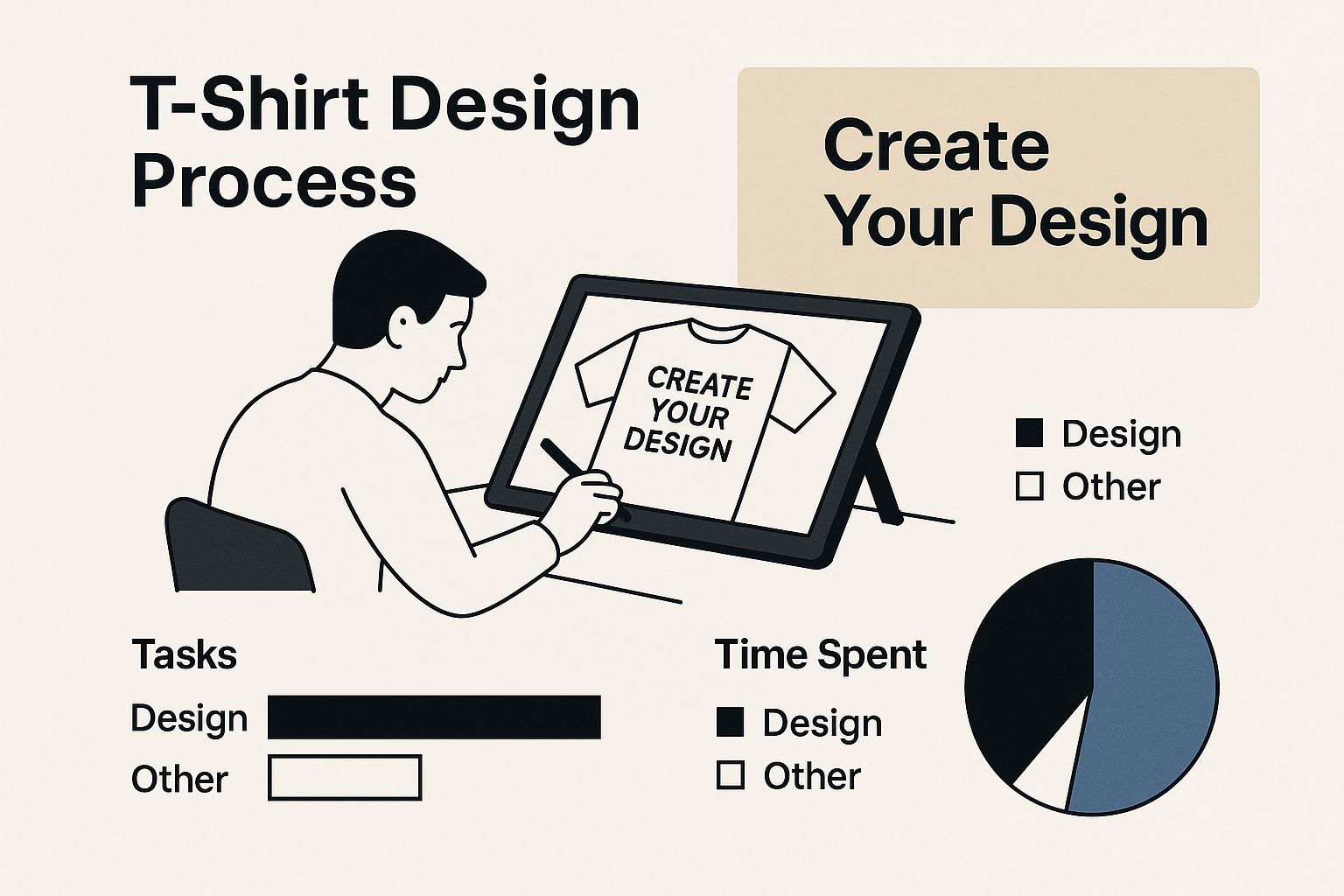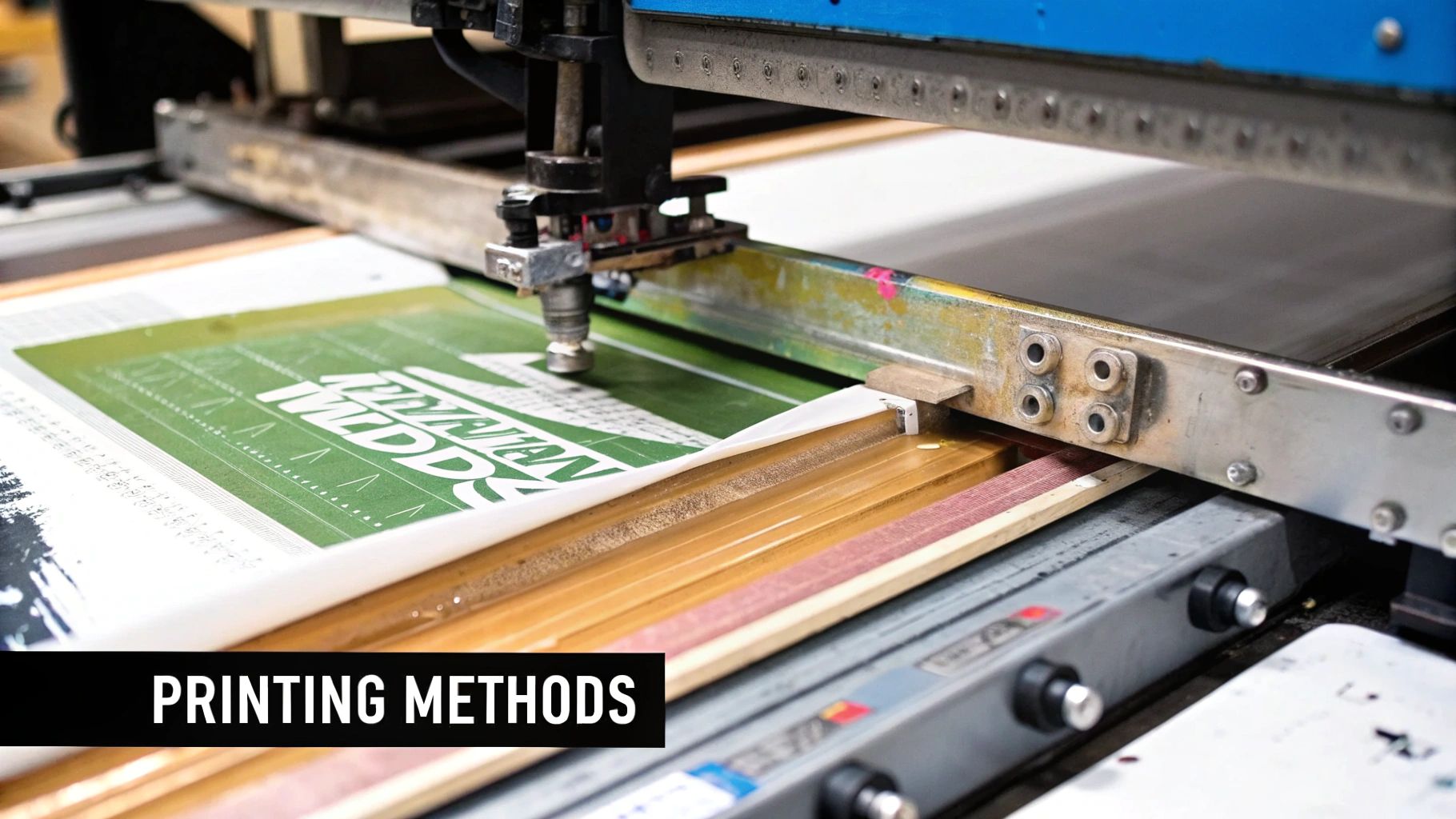
Your Guide to T Shirt Custom Printing
Share
Putting your own design on a t-shirt does more than just make it look cool. It turns a piece of everyday clothing into a billboard, a uniform, or a memory you can wear. It’s how you take an idea from your head and put it on a blank tee, creating something that’s 100% you. This guide will show you how it’s done.
Why Custom T-Shirts Are More Than Just Fabric
Ever had a brilliant idea for a t-shirt—a perfect inside joke, a killer logo for your brand, or a design that just screams you? You're not the only one. People are tired of the same old mass-produced stuff. They want clothes that mean something, that tell a story. T-shirt custom printing is the bridge between that flicker of an idea and a real, wearable product.
This isn’t just some passing fad; it’s a total shift in how we think about what we wear. A custom tee can be a walking advertisement for a new business, a badge of unity for a sports team, or a souvenir from an unforgettable family reunion. It’s a canvas for whatever you want to say.
The Power of Personalisation
The demand for custom gear is exploding, driven by everyone from individuals to massive companies who want to stand out. And the numbers back it up. The UK custom T-shirt printing market is expected to jump from USD 310.48 million in 2023 to a massive USD 526.78 million by 2032. That insane growth shows just how accessible and popular personalised clothing has become. You can dig into more data about this market trend and see what’s fuelling the fire.
A custom t-shirt isn't just about the design on the front; it's about the idea behind it. Whether it's for a company event, a charity run, or a one-off gift, each shirt has a purpose. That gives it way more value than the cotton it’s printed on.
Making Your Vision a Reality
What used to be a complicated, expensive process is now ridiculously simple, thanks to modern tech. High-quality printing methods mean anyone can create professional-looking gear, whether you need one shirt or a thousand. This guide is here to cut through the noise and help you:
- Figure out the different printing methods
- Get your design print-ready
- Pick the right t-shirt for the job
Creating the perfect custom t-shirt is a straightforward and creative ride. We'll walk you through it, step by step.
Choosing the Right Printing Technique for Your Project
Picking the right method for your t shirt custom printing project is a bit like choosing your weapon for battle. You wouldn't bring a knife to a sword fight, and you wouldn't use the wrong print tech for the design you've poured your soul into. Getting this right from the start is the key to creating a tee that looks incredible, not just mediocre.
Each method has its own turf. Some are perfect for that one-off, insanely detailed masterpiece, while others are built to churn out hundreds of identical shirts without breaking the bank. Let's cut through the noise and figure out which one actually fits what you're trying to do.
The Modern All-Rounder: Direct-to-Film (DTF)
Think of Direct-to-Film (DTF) printing as the new champion of custom apparel. It’s a game-changer. The process is straightforward: your design is printed onto a special film, coated with an adhesive powder, and then heat-pressed directly onto the shirt. The result is a vibrant, flexible print that feels surprisingly smooth and holds up to some serious wear and tear.
The real magic of DTF is its versatility. It doesn't care what fabric you throw at it. Cotton, polyester, weird blends, dark colours – DTF handles them all without losing a drop of vibrancy. This makes it the go-to choice for complex, full-colour designs that need to explode off the fabric, no matter what it’s made of.
This is where the process kicks off – turning raw ideas into printable art.

As you can see, the creative work starts on a digital canvas long before any ink hits the fabric.
Classic Methods and When to Use Them
While DTF is a killer all-rounder, the old-school methods still have their place. Screen printing, for example, is the undisputed king of bulk orders with simple graphics. Think of it like a stencil. A mesh screen is made for each colour in your design, and ink is pushed through it onto the shirt.
The setup is a pain for a single tee, but for 50 or more identical items, it becomes brutally efficient and cheap. It creates super durable, punchy prints, which is why it’s been the favourite for band merch and event staff shirts forever. For a head-to-head breakdown, check out our in-depth comparison of DTF vs screen printing for graphic tees.
Then you've got Direct-to-Garment (DTG), which is basically an inkjet printer for t-shirts. It's amazing for printing photorealistic designs on 100% cotton, but it gets fussy with polyester. Lastly, Heat Transfer Vinyl (HTV) involves cutting your design from a sheet of coloured vinyl and pressing it on. It’s perfect for bold, clean graphics like names and numbers on a sports jersey.
Choosing a printing method comes down to a three-way battle: design complexity, order quantity, and fabric type. Nail that balance, and you've got a perfect print.
Comparing T-Shirt Printing Methods
To make this dead simple, here’s a side-by-side comparison of the most popular custom t-shirt printing techniques. It’s the ultimate cheat sheet to help you choose the right one for your project.
| Printing Method | Best For | Durability | Colour Vibrancy | Ideal Fabric |
|---|---|---|---|---|
| Direct-to-Film (DTF) | Detailed, multi-colour designs in any quantity. | Excellent | High | Cotton, Polyester, Blends |
| Screen Printing | Simple designs (1-4 colours) in large batches (25+). | Excellent | High | Cotton, Blends |
| Direct-to-Garment (DTG) | Photo-realistic images on single or small orders. | Good | Excellent | 100% Cotton |
| Vinyl Transfer (HTV) | Bold text, numbers, and simple logos. | Very Good | Excellent | Cotton, Polyester, Blends |
With this table, you can instantly see which method aligns with what you need. Whether it's a single, complex photo tee for yourself or a massive run of event shirts for your crew, you can now pick the most suitable and cost-effective printing tech for the job.
Creating a Design That Looks Amazing When Printed
An incredible idea is the heart of any custom t-shirt, but a poor-quality design file can stop it dead in its tracks. Getting your artwork ready for print is the single most important thing you can do to make sure the final shirt looks sharp, professional, and exactly how you pictured it. It’s the bridge between what’s on your screen and a real, wearable piece of art.
You don’t need to be a pro graphic designer to get this right, but you do need to understand a few key principles. By nailing the basics of file quality and design placement, you guarantee the t-shirt custom printing process goes off without a hitch and delivers killer results.

Why File Quality Is Everything
Think of your artwork's resolution like a photograph—more pixels mean a sharper, clearer image. For printing, the gold standard is 300 Dots Per Inch (DPI). This resolution is what stops your design from looking blurry, pixelated, or just plain fuzzy when it’s printed onto fabric.
A low-resolution image might look fine on your phone screen, but when you blow it up for a t-shirt, all its flaws become glaringly obvious. Always start with the highest quality file you can get your hands on; you can always shrink an image down, but you can’t add detail that was never there to begin with.
This brings us to file types. For t-shirt printing, a PNG file is usually your best friend because it supports transparent backgrounds. That means only your actual design gets printed—not a clunky white or coloured box around it. JPEGs are common, but they don’t do transparency and their compression can sometimes mess with your image quality. If you want ultimate quality that can be scaled to any size without losing sharpness, vector files (like AI or SVG) are unbeatable, but a high-res PNG will work perfectly for most print jobs.
Actionable Tips for a Standout Design
Beyond the tech specs, the creative choices you make are what will decide if your t-shirt turns heads or just gets lost in the crowd. A perfectly prepared file is crucial, but so is a design that’s been thought through.
Here are three core areas to lock down:
- Colour and Contrast: Pick colours that actually pop against the shirt fabric. A dark design on a navy shirt is just going to disappear. Test your palette to make sure there’s enough contrast for your design to be clear and readable from a distance.
- Typography Choices: If you’ve got text in your design, readability is everything. Stay away from super thin or complicated fonts that can turn into a smudged mess on textured fabric. Go for clear, bold fonts that get your message across loud and clear.
- Strategic Placement: The standard chest print is a classic for a reason, but don’t be scared to experiment. Think about putting smaller designs on the left chest, the sleeve, or the upper back. Picture how the design will actually look and move when someone is wearing the shirt.
When you combine a high-quality file with smart design decisions, you’re setting yourself up for a win. For more ideas on crafting a look that’s truly your own, our guide on creating a personalised t-shirt print has a few more tricks up its sleeve.
Selecting the Perfect T-Shirt for Your Design
Think of the t-shirt as the canvas for your art. Choosing the right one is just as important as the design itself, because the fabric, weight, and fit all have a massive impact on how the final print looks and feels. A bad canvas can ruin a masterpiece, and a bad t-shirt can ruin a killer design.
Your choice of material is ground zero. Different fabrics drink ink in different ways, which completely changes the final vibe. Getting this right is the key to making sure the garment and the graphic work together.
Understanding Fabric and Feel
The undisputed king is 100% cotton. It’s soft, it breathes, and it has that classic, familiar feel everyone loves. It also provides a brilliant surface for printing, especially for methods that bond best with natural fibres. We get into the nitty-gritty of how different print methods play with fabrics in our guide on direct printing to garment.
For anything athletic or performance-related, 100% polyester is your go-to. This stuff is tough, wicks sweat away like a pro, and fights off shrinking and wrinkles. It can have a slicker, shinier feel and needs specific printing techniques like DTF to really make colours pop without any issues.
Can’t decide? A cotton/polyester blend gives you the best of both worlds. You get the softness of cotton mixed with the durability and moisture-wicking power of polyester. This makes them a super versatile and popular choice for pretty much anything.
Getting the Weight and Fit Right
Beyond the material itself, the garment's weight—measured in Grams per Square Metre (GSM)—tells you how thick and sturdy it is.
- Lightweight (Under 150 GSM): These are your thin, breezy tees. Perfect for hot weather or as an undershirt, but they can be a bit on the sheer side.
- Midweight (150-180 GSM): This is the sweet spot and the standard for most custom shirts. It’s a solid balance of comfort and durability without feeling like you’re wearing a blanket.
- Heavyweight (180+ GSM): Thick, rugged, and built to take a beating. These have a more structured, premium feel that’s ideal for streetwear or proper workwear.
The fit is the final piece of the puzzle. Whether you're after a classic relaxed fit, a sharp slim fit, or a modern oversized style, make sure it matches your brand's personality and what your audience actually wants to wear. A phenomenal design on a shirt that fits badly will always fall flat. Nail the fabric, weight, and fit, and you'll end up with something that doesn’t just look incredible, but feels amazing to wear.
How to Place Your T Shirt Custom Printing Order

You’ve nailed the design and picked the perfect tee. Awesome. Now for the final step: turning your idea into a real, wearable piece of art. Placing your t shirt custom printing order should feel like the victory lap, not a chore. It's all about getting your creative choices locked in without any last-minute drama.
Thankfully, most modern printers have made this ridiculously easy. The UK’s custom printing scene is moving online, fast. Digital ordering is set to explode with a projected 13.3% growth rate from 2025 to 2030. That boom means websites are built to be intuitive, guiding you from upload to checkout without a headache. You can dig into the numbers in this in-depth analysis of the UK custom printing market.
Your Step-by-Step Ordering Checklist
Navigating the checkout process is simple once you know what to watch out for. Use this checklist to make sure you’ve covered all the bases before hitting that "confirm" button. Think of it as your pre-flight check to avoid common mistakes.
- Upload Your Artwork: First things first, get your high-resolution PNG or vector file uploaded. Spend a moment with the on-screen preview. Does the design look exactly how you imagined it? This is your chance to catch any issues.
- Select Sizes and Colours: Now, pick your garment colours and punch in the quantity for each size you need. Double-check your numbers here – it’s the most common spot for little mistakes that cause big problems.
- Review the Digital Proof: Stop and pay attention. This is your most critical checkpoint. The digital proof, or mock-up, shows you what your design will actually look like on the t-shirt, including its scale and placement. Scrutinise it. Is it centred? Is it big enough?
- Confirm Production and Shipping Times: Check the estimated production timeline and delivery options. Need it in a hurry? Many printers offer express services for tight deadlines. If you’re really up against it, our guide on getting next day delivery custom t-shirts has some killer tips.
Always take a final moment to scan everything on the checkout page. Seriously. One last look at quantities, sizes, colours, and the shipping address. This simple habit can save you from a world of expensive, frustrating hassle.
Inspiring Ideas for Your Custom T-Shirts
Alright, so you’ve got the technical side of t shirt custom printing down. Now for the fun part: figuring out where these techniques really come alive. A custom t-shirt is a blank canvas, ready to tell a story, build a connection, or celebrate a moment you’ll never forget. From corporate branding to deeply personal projects, the possibilities are literally endless.
For businesses, custom tees are an absolute powerhouse. Picture a local coffee shop where the staff wear soft, cotton t-shirts with a crisp, single-colour logo. Screen printing would be perfect for that—it’s durable, professional, and looks killer. Now, think about a tech start-up getting its team ready for a trade show. They'd probably go for vibrant, full-colour DTF prints on moisture-wicking polyester, making sure their brand pops in a sea of competitors.
For Teams and Communities
Nothing builds a sense of identity like custom gear. For sports teams and community groups, it’s essential. A local football club can instantly create unity with bold names and numbers pressed on with Heat Transfer Vinyl. It delivers that sharp, classic athletic look and is brilliant for personalisation and smaller batches, making every single player feel like part of the unit.
It’s happening on a national level, too. Government investment in sport has fired up demand for apparel that builds team identity. Take the Rugby Football Union’s 'Impact '25' initiative—backed by over £12 million in funding—which is all about growing women's rugby. That means a bigger need for custom kits that build visibility and fierce pride.
The right t-shirt transforms a bunch of individuals into a unified team. It's not just about wearing the same colour; it's about sharing an identity and a purpose that everyone can see.
Personal Projects and Unforgettable Gifts
Custom t-shirts are also perfect for bringing personal moments to life. Think about creating unforgettable memories for a stag or hen party, where hilarious photos or inside jokes are printed using DTG for super-detailed, one-off designs. Or for a big family reunion, a simple, elegant design screen-printed across dozens of shirts becomes a keepsake everyone will actually cherish.
From bold promotional gear to heartfelt personal gifts, the perfect mix of design, fabric, and printing technique can turn a simple garment into something genuinely meaningful. When you're ready to bring your own idea to life, you can browse a massive variety of customisable t-shirts to find the perfect canvas for your next project.
Right, you've got your killer design ready to go, but you're probably still weighing up a few things about the actual t shirt custom printing side of things. Nailing these details is what separates a good-looking tee from a drawer-filler, so let's get into the questions we hear all the time.
What's the Minimum Order for Custom Tees?
This one comes down to the tech being used. Modern methods like Direct-to-Garment (DTG) and Direct-to-Film (DTF) are absolute game-changers for one-off prints. Think of them like a badass desktop printer for fabric—there's almost no setup, so ordering a single shirt is easy and doesn't cost a fortune.
Screen printing, on the other hand, is the undisputed king of bulk orders. It's an old-school craft that involves creating a physical screen for every single colour in your design. Because of that initial setup, it only makes sense financially when you're printing a bigger batch, usually 25 shirts or more. Always ask your printer what their sweet spot is.
How Long Is This Print Actually Going to Last?
The lifespan of your print is a battle between the printing method and your washing machine. High-quality prints from methods like DTF and screen printing are built to last; they can look sharp for years if you treat them right.
Want your print to outlive your favourite band? Always wash your tee inside out on a cool cycle. And for the love of all things sacred, keep it out of the tumble dryer. High heat is the mortal enemy of any printed design.
DTG prints are also solid, but you might notice some gentle fading after a ton of washes, especially on darker shirts. Good aftercare is your best weapon for keeping any print looking as fresh as the day you got it.
Can I Get a Photo Printed on a T-Shirt?
You absolutely can. In fact, printing photos or complex designs with loads of colours and smooth gradients is where modern printing tech really flexes its muscles.
For mind-blowing detail on 100% cotton, Direct-to-Garment (DTG) is a brilliant pick. It works just like a high-res photo printer, but for your clothes. Direct-to-Film (DTF) is another monster of a choice, delivering photo-realistic results on a huge range of fabrics—even those tricky polyester blends that other methods struggle with. You'll get sharp, vibrant images every single time.
Ready to turn your vision into wearable art that doesn't fade away? At Psyque, we live and breathe DTF printing to make sure your designs hit hard. Start creating your custom apparel with us today!
